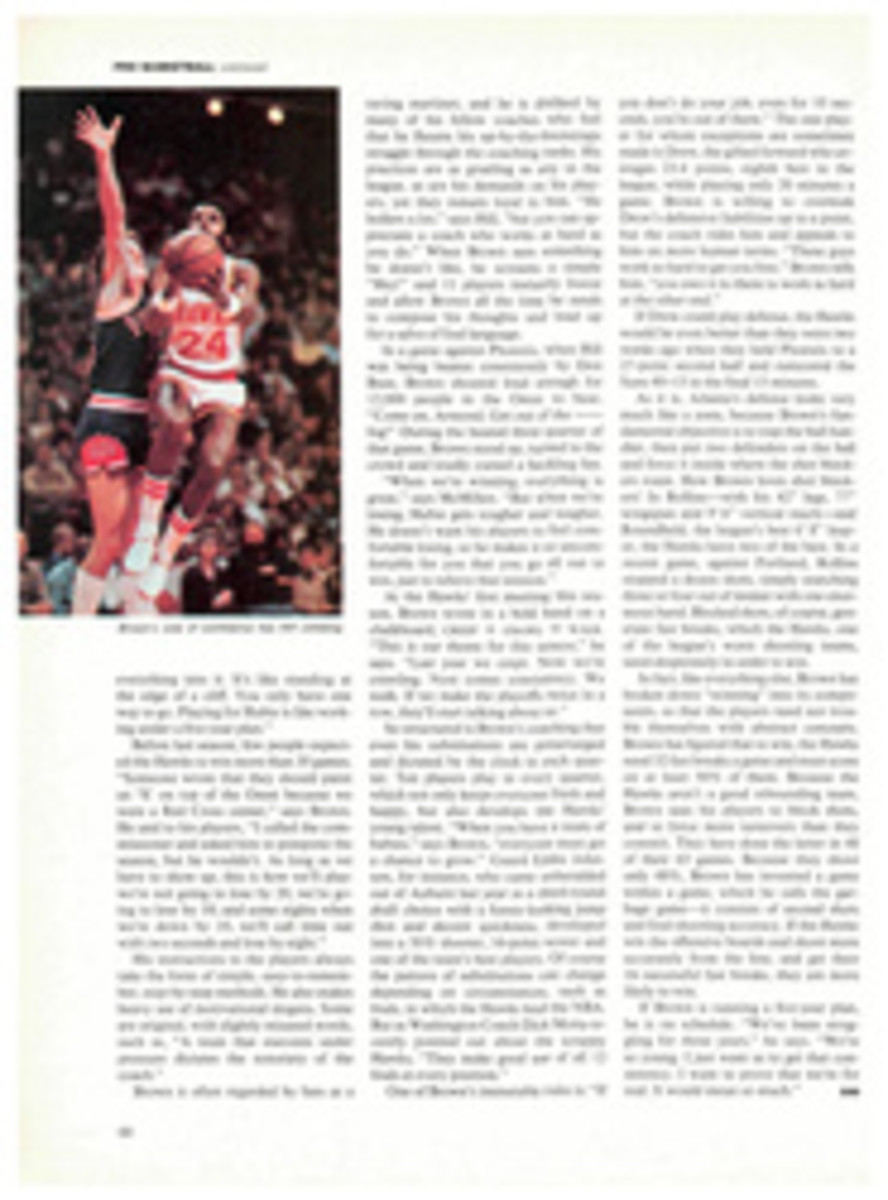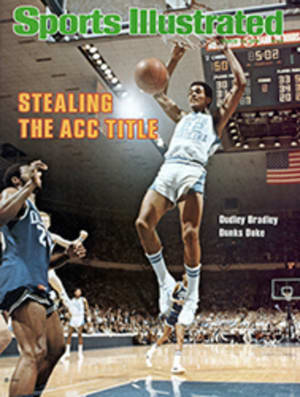
Believe it or not, the U.S. won
In recent weeks the Soviet Union has been touring America with a traveling athletic show entitled "The Russians Are Winning! The Russians Are Winning!" First came a hockey team, which humiliated the NHL All-Stars 6-0 in Madison Square Garden to win the rubber match of a three-game series. Next came a basketball team, which embarrassed 13th-ranked Louisville, 91-76, on the Cardinals' home court. Last Saturday night the Soviet tour reached Fort Worth in the form of a powerhouse track team scheduled to meet an American squad that was as noteworthy for the athletes not on its roster as for the ones that were.
The missing persons included world-record-holding hurdler Renaldo Nehemiah, who opted to compete for his school, Maryland, in the IC4A meet at Princeton, and Fairleigh Dickinson high jumper Franklin Jacobs, who had announced he, too, would compete in the IC4A, but was prevented from doing so by a bruised heel. Other absentees included middle-distance stars Mark Belger, Steve Scott and Marty Liquori, all of whom bowed out for personal reasons. Was it any wonder, then, that Stan Wright, the American coach, had likened his team to football's No-Name Defense?
But like the No-Name Defense, Wright's wrong names rose to the occasion. In a town whose slogan is "Where the West Begins," the U.S. pulled a stunning upset, downing the U.S.S.R. 121-118. The victory belonged to the men, who beat their Soviet counterparts by nine points to compensate for the American women's six-point loss. And the evening belonged to pole vaulter Dan Ripley, who was named the meet's outstanding competitor after he set a world record with a leap of 18'5½". Ripley had been flirting with Mike Tully's mark of 18'5½" for a month and a day. In six meets in five cities in two countries he had made 16 attempts at a world-record height before he finally soared cleanly over the bar in the Tarrant County Convention Center. Ripley and Earl Bell, who cleared 17'4", provided a one-two American finish that gave the U.S. a six-point margin in an event that had seemed too close to call before the meet.
Earlier, a U.S. victory had hardly seemed possible. Wright knew he had his hands full when he greeted the Soviet team at the Dallas-Fort Worth Airport Tuesday night. Off the plane came four athletes who were ranked No. 1 in the world last year in their specialties—high jumper Vladimir Yashchenko, hammer thrower Yuri Syedikh, pole vaulter Vladimir Trofimyenko, and 800-meter runner Tatyana Providokhina. In addition, there were two new world-indoor-record holders: high hurdler Andrey Prokofiev and triple jumper Gennady Valyukevich. Spotting Igor Ter-Ovanesyan among the Soviet coaches, Wright said to the former long-jump world-record holder, "Your team is loaded." Ter-O speaks excellent English, but on this occasion words weren't necessary. He just smiled smugly and nodded.
But if the Soviets had come west with the horses, they had little else in their favor. Their team had competed in the European Indoor Championships in Vienna the previous weekend, then flown back to Moscow for two days before making the 15-hour flight to Fort Worth. When the meet started at 6:30 p.m. Saturday, it was 4:30 a.m. in Moscow. Moreover, the Soviets are less accustomed to competing indoors, which their head coach, Nikolai Politiko, pointed out by saying, "We do not have many under-the-ceiling arenas." And there was the question of conditioning. When Maria Kulchunova, the fourth-ranked woman in the world at 400 meters, finished last in the 440, a U.S.S.R. coach said, "I think she is without shape."
A combination of these factors probably explains some surprisingly poor Soviet performances, such as that of Trofimyenko, who no-heighted in the pole vault. There were four competitors in each event, with scoring on a 5-3-2-1 basis, but Trofimyenko wasn't even entitled to the point for last place. If he had been able to clear the opening height of 17 feet, and if his fellow vaulter, Yevgeny Tananika, who was ranked sixth in the world last year, could have beaten out Bell for second place, the meet would have ended in a 120-120 tie.
The Americans got off to a fast start. Literally. Sixteen-year-old Candy Young, who set a world record of 7.50 in the 60-yard hurdles at the AAU championships the previous week, came out of the blocks so fast that she had virtually won her race by the time she reached the first hurdle. It was an impressive international win because the Soviet entries, Tatyana Anisimova and Nina Morgulina, were ranked third and fifth in the world last year. It seemed more impressive when the public-address announcer gave Young's time as 7.27, which would have been an amazing .23 under her week-old world record. "I was surprised when I heard that," Young admitted later. "I figured something was wrong."
Something was. The automatic timer had malfunctioned and the 7.27 was a hand time. Instead of a world record, Young had to be content with equaling the hand-timed mark of 7.3 (hand times are rounded to the highest tenth of a second), held jointly by Jane Frederick and Deby LaPlante.
No sooner was the Accutrack working again than it recorded a world record 6.63 in the 60-yard dash for Lyudmila Storozhkova of the Soviet Union. That broke the mark of 6.71 set at the AAUs by Evelyn Ashford, another American athlete who passed up this meet for personal reasons. Storozhkova had described her race as "slow" before a translator informed her of the time. Faced with this surprising bit of news, she simply shrugged.
Earlier in the week, Storozhkova had reflected the concern of many of her teammates that her translated comments might be misconstrued by the American press. On their first night in Fort Worth, the Soviets were taken to a local brewery for what was described as a "beer bust." At a press conference the next day, she was asked if she had drunk any beer. She answered at some length before Ter-Ovanesyan translated, "Yes. She said she drank a little. But she didn't like it." The translator was asked what else she had said. He smiled. "She said that you would probably write that she was a drunkard."
Most of the Soviet women were apparently with shape, because other than Young and another 16-year-old, Sherri Howard of San Bernardino, who won the 440, only one American managed to win an event. That was Jan Merrill, who took an exciting two-mile run in 9:41.5. By the time Ripley made his second attempt at 18'5½", the women's competition was over, with the U.S.S.R. 52-46 winners. That was a better American performance than many experts had believed possible and Wright could already sense the upset. The day before, he had predicted that the team competition would be decided in the men's jumping events, in which the Soviets appeared to be overwhelmingly strong.
Wright's hopes got an unexpected boost in the long jump when Vladimir Tsepelyev and Valery Podluzhniy, ninth and 13th in the world the previous year and one-two in the European indoor championships, could not better the 25'10¼" jump of Theo Hamilton, who wasn't even ranked in the U.S. in 1978. Then Benn Fields, who cleared 7'5", and Jim McDaniel took second and third in the high jump between Yashchenko, who won at 7'6", and Gennady Byelkov, who had finished second to his record-setting teammate at the European Championships. Combined with the 8-2 margin in the pole vault, this gave the U.S. enough of a cushion to withstand the Soviet Union's dominance of the triple jump.
When Ripley missed the first try at the record, he could feel that his pole wasn't stiff enough. Bell, who was critiquing his jumps, agreed, so Ripley switched from a 6.2 pole to a 6.1. Those numbers measure in inches the amount a pole will deflect when a 50-pound weight is hung from its middle. Ripley also asked that the standards be moved forward one inch, reasoning that the less flexible pole wouldn't let him get as far into the pit. His calculations proved correct. Ripley cleared the bar easily and afterward estimated that his jump would have put him over a bar two or three inches higher. No one who witnessed the jump disagreed.
Ripley had almost joined Nehemiah, Jacobs, Liquori et al. on the sideline. The U.S. team was supposed to be composed of the top two American finishers in each event at the AAUs, but even though Ripley had won in Madison Square Garden, he had to be talked into going to Fort Worth by Bell, who had been second.
In an even more curious way, Bell was as resposible for the record-setting pole as he was for Ripley's presence. The pole was one recently built for Ripley because his last 6.1 pole had been lost. It seems that last summer when Ripley and Bell were in Europe, Ripley had loaned the pole to his friend. Bell in turn loaded it onto an overnight train in Italy, went to sleep and woke up to find it gone.
Ripley had had a small role in the manufacture of the record-setting pole when he visited the Pacer factory in Carson City, Nev. late in January. A band denoting the pole's flexibility was being wrapped around it as Ripley watched. Now on that band, covered by a final layer of fiberglass, in Ripley's own printing are the words SPECIAL EDITION. Out where the West begins, that edition turned into a Saturday night special that stopped the Russian team cold in its track.
PHOTO
Ripley was a reluctant entrant in the meet, but his 18'5½" vault sealed a victory for the U.S.

